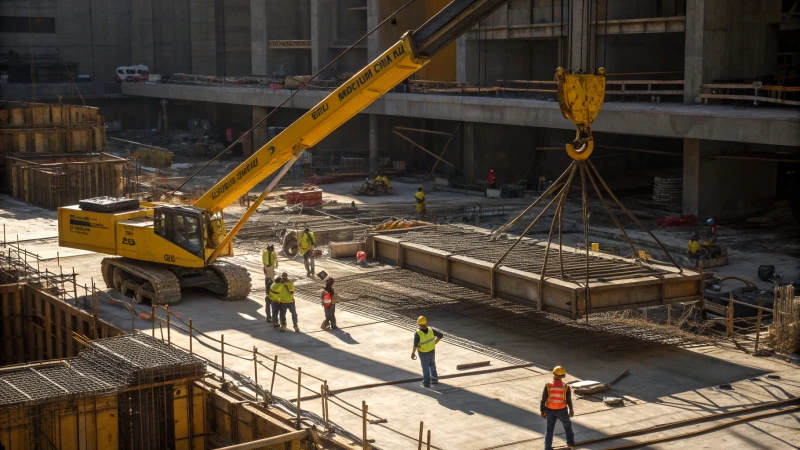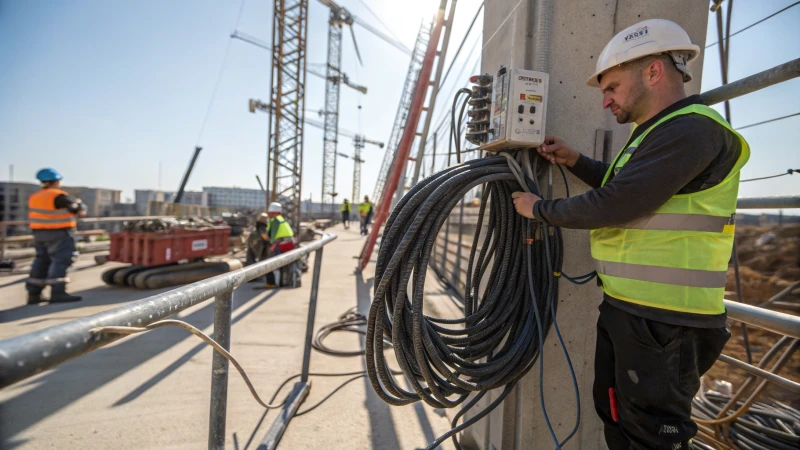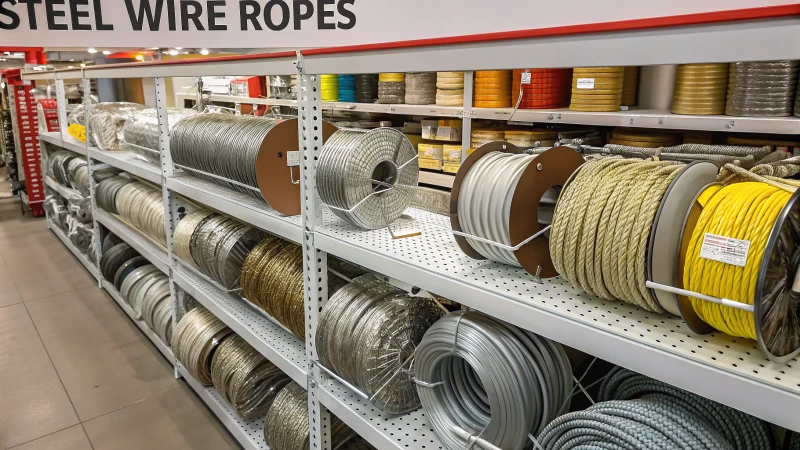
Ever wondered how something as simple as a steel wire rope can hold the entire construction world together?
Heavy-duty steel wire ropes are crucial in construction for lifting, rigging, and structural support. They offer the strength and flexibility needed to manage heavy loads and ensure safety across various applications.
I remember the first time I saw a massive crane in action, its intricate dance of lifting tons of steel with effortless grace, all hinging on the reliability of those steel wire ropes. While their primary functions in lifting and rigging are well-known, innovations in steel wire rope technology are continuously reshaping the construction landscape. Imagine ropes with embedded sensors offering real-time monitoring—this is not just futuristic talk but a reality that's enhancing safety and efficiency. Staying informed about these advancements isn't just a luxury; it's a necessity for anyone involved in construction.
Steel wire ropes are used for lifting in construction.True
They provide necessary strength and flexibility for heavy loads.
Innovations in steel wire rope have no impact on construction.False
Technological advancements reshape the construction landscape significantly.
How Do Steel Wire Ropes Enhance Safety in Construction?
Imagine being on a construction site where every lift feels as secure as a warm hug. That’s the magic of steel wire ropes, ensuring safety and reliability with every hoist.
Steel wire ropes enhance construction safety through their robust tensile strength, adaptability, and resilience. They are crucial for securely lifting heavy loads, minimizing accidents, and ensuring steady operations.

The Role of Steel Wire Ropes in Lifting Operations
I remember the first time I saw a skyscraper crane in action, the steel wire ropes glinting in the sun as they effortlessly hoisted massive steel beams. It was like watching a well-choreographed dance. These ropes are the unsung heroes in lifting operations, with their incredible tensile strength that supports hefty loads without snapping. This reduces the risk of accidents, which is absolutely essential when you're working in high-risk environments1.
Characteristics That Enhance Safety
Steel wire ropes are like the Swiss Army knife of construction—versatile and reliable. Their flexibility is what makes them glide smoothly over pulleys and winches, reducing wear and tear. It's this durability that allows them to withstand harsh weather conditions and maintain their performance over time.
| Characteristic | Safety Benefit |
|---|---|
| High Tensile Strength | Prevents rope failure during heavy lifting |
| Flexibility | Reduces wear and enhances maneuverability |
| Durability | Extends lifespan in tough conditions |
Just like how my trusty old boots have seen me through countless adventures, these ropes are built to last, enhancing their longevity and performance2.
Advanced Features in Modern Steel Wire Ropes
In today's tech-savvy world, even steel wire ropes are getting a high-tech makeover. Imagine ropes equipped with sensors that alert you to stress points before they become issues—like a fitness tracker for construction equipment! This advancement allows for preemptive maintenance, significantly reducing the chances of unexpected accidents3. It's like having a guardian angel looking out for your operations.
Importance of Compliance with Safety Standards
Compliance with safety standards like ISO and ASTM isn't just a box to tick off; it's a lifeline. Ensuring that steel wire ropes meet these standards means they can handle pressure reliably, keeping everyone on site safe. I always say it's like trusting your seatbelt to hold tight when it matters most.
- ISO 2408: Specifies requirements for steel wire ropes used in lifting applications.
- ASTM A1023/A1023M: Covers general requirements for steel wire rope products.
Understanding these standards helps procurement managers like John and Lucy make informed choices about which products align with industry requirements4. It’s about selecting ropes that perform efficiently while adhering to top safety measures—like choosing the right ingredients for a recipe to ensure it turns out just right every time.
Steel wire ropes have high tensile strength.True
They support substantial weights without breaking, crucial for lifting.
Modern steel wire ropes lack embedded sensors.False
They have sensors for real-time monitoring, boosting safety by detecting stress.
What Are the Different Types of Steel Wire Ropes Used in Construction?
Steel wire ropes are more than just tools—they’re lifelines in construction projects, transforming plans into reality.
In construction, various steel wire ropes like galvanized for corrosion resistance, stainless steel for strength, and compacted strands for flexibility are essential. These ropes are crucial for applications such as cranes and elevators.

Galvanized Steel Wire Ropes
I remember standing on a bustling construction site, the air filled with the clatter of machinery and the distant hum of city life. Amongst all the chaos, the unsung heroes were the galvanized steel wire ropes. These ropes, with their protective zinc coating, were like old friends—reliable and steadfast, especially in the unpredictable weather conditions we often faced. Their corrosion resistance5 made them indispensable for outdoor projects, where durability over time was not just a preference but a necessity.
Stainless Steel Wire Ropes
In a project where aesthetics mattered as much as structural integrity, I found stainless steel wire ropes to be the perfect fit. Known for their high tensile strength and resistance to rust, these ropes were essential in environments where both hygiene and robustness were paramount. I recall using them in bridge construction6 projects where their sleek appearance paired beautifully with their unyielding strength.
Compacted Strand Wire Ropes
Ah, the compacted strand wire ropes—like the flexible dancers of the construction world. These ropes undergo a special compaction process that enhances their strength and minimizes wear. I’ve seen them handle dynamic applications like crane operations7 with grace and ease, their smooth surface reducing abrasion and extending their lifespan. It's like having a versatile athlete on your team.
| Type | Characteristics | Applications |
|---|---|---|
| Galvanized | Corrosion-resistant | Outdoor use |
| Stainless Steel | High strength, rust-resistant | Bridges |
| Compacted Strand | Flexible, wear-resistant | Cranes |
Rotation-Resistant Wire Ropes
When working on high-rise constructions, stability was our watchword. I relied on rotation-resistant wire ropes to minimize rotation under load—a crucial feature for hoisting systems8 where safety is non-negotiable. Their design prevented untwisting under tension, providing peace of mind in every lift.
Plastic Coated Wire Ropes
In certain scenarios, we needed more than just strength; we required protection from environmental damage and abrasion. That's when plastic coated wire ropes came into play. These ropes were ideal in applications demanding non-conductivity or exposure to harsh chemicals.
Understanding these different types of steel wire ropes has been essential for me—and I imagine for procurement managers like John or Emma too. It's all about matching the right rope to the right job, ensuring safety and efficiency on site.
Galvanized steel ropes are ideal for marine environments.True
Galvanized ropes resist corrosion, making them suitable for marine use.
Plastic coated ropes are not useful in chemical environments.False
Plastic coatings protect ropes from harsh chemicals, aiding their use.
How Are Sensor-Embedded Ropes Revolutionizing Construction Safety?
Ever wondered how something as simple as a rope could redefine safety on a construction site?
Sensor-embedded ropes are changing the game in construction safety by providing real-time monitoring of load stress and environmental conditions, which helps prevent accidents and boost operational efficiency.

The Technology Behind Sensor-Embedded Ropes
Imagine standing on a bustling construction site, surrounded by the clamor of machinery and the buzz of activity. As someone who’s spent years navigating these environments, I understand the vital role every piece of equipment plays in maintaining safety. That's where sensor-embedded ropes come in. These ropes are not just simple tools but smart devices that incorporate micro-sensors within their fibers. These sensors meticulously monitor parameters like tension, load, and temperature, sending data wirelessly to a central system.
I remember the first time I heard about this technology. It felt like stepping into a sci-fi movie where ropes could talk to us, alerting operators of potential overloads before a failure occurs. This proactive monitoring is like having an extra set of eyes on site, ensuring accidents caused by undetected rope wear or misuse are minimized.
| Parameter | Functionality |
|---|---|
| Tension | Monitors load |
| Temperature | Detects heat |
| Vibration | Analyzes movement |
Benefits of Sensor-Embedded Ropes
The beauty of these sensor-embedded ropes is how they transform safety practices9 in the construction industry. The real-time data they provide can prompt immediate corrective actions, dramatically reducing the chances of catastrophic failures. I often think about how fewer workplace injuries and lower insurance premiums would have made my early project days less stressful.
Besides enhancing safety, these ropes also contribute to operational efficiency10. I’ve seen firsthand how data can be used to schedule maintenance proactively, minimizing downtime and extending equipment lifespan—music to any project manager's ears.
Applications in Construction
Sensor-embedded ropes are versatile, finding applications in cranes, hoists, and elevators. I recall overseeing a crane operation where these ropes ensured loads were always within safe limits—imagine the peace of mind that brings. Similarly, in elevators, they provide crucial data on rope integrity, preventing malfunctions before they happen.
Adopting this technology not only elevates safety standards but also aids companies in meeting stringent industry regulations with ease. The leap towards safer and more efficient operations is unmistakable as technology advances, promising even more innovative applications to revolutionize construction safety practices further.
Sensor-embedded ropes can measure temperature changes.True
These ropes monitor temperature to detect heat, preventing potential failures.
Sensor-embedded ropes increase construction downtime.False
They reduce downtime by allowing proactive maintenance scheduling.
What should you consider when choosing steel wire ropes for your project?
Steel wire ropes might seem like just another component, but choosing the right one can make all the difference in your project. From cranes to elevators, the right rope ensures safety and performance.
When selecting steel wire ropes, focus on tensile strength, flexibility, diameter, and corrosion resistance. These factors determine the rope's effectiveness and are crucial for applications like cranes and hoists.

Understanding Tensile Strength and Flexibility
Tensile strength determines how much load a wire rope can handle before breaking. When selecting for heavy-duty applications, such as in cranes or hoists11, a higher tensile strength is essential. I've learned the hard way that not all ropes are created equal. Flexibility is equally crucial as it affects how easily the rope can bend without breaking. For instance, ropes used in cranes often require high flexibility to maneuver loads efficiently.
Diameter and Construction
The diameter of a wire rope isn't just a number; it's a lifeline influencing its load-bearing capacity. A larger diameter typically equates to higher strength but can reduce flexibility. I once had to choose between two ropes for a construction project: one thicker for lifting massive loads and one thinner for better flexibility in tight spots. When deciding on the right rope construction12, consider the number of strands and wires per strand. Each configuration offers different advantages; some are better suited for heavy lifting, while others excel in bending and rotation resistance.
| Diameter (mm) | Typical Use |
|---|---|
| 10-15 | Light lifting, small pulleys |
| 16-25 | General construction tasks |
| 26-35 | Heavy-duty applications |
Corrosion Resistance and Coatings
Corrosion can sneak up on you if you're not careful, especially in environments where exposure to moisture or chemicals is a concern. Options like galvanized13 or stainless steel ropes offer excellent protection against rust and corrosion. I had this experience with a project near the coast where saltwater exposure was a major concern. Galvanized ropes saved the day—they offered that extra layer of protection against rust.
Safety Standards and Certifications
You can't compromise on safety—ever. Compliance with industry safety standards ensures that the wire ropes meet necessary requirements for strength and durability. Ensuring that the steel wire ropes meet industry standards is non-negotiable. Look for certifications from recognized bodies to confirm that the ropes are tested for safety and quality; it's peace of mind knowing they are reliable, especially in sectors like construction or marine where safety is paramount.
By considering these factors, you can choose a steel wire rope that truly meets the demands of your project. Dive into additional resources to feel confident about your choices.
Higher tensile strength is crucial for crane ropes.True
Cranes require ropes with high tensile strength to handle heavy loads safely.
Larger diameter ropes are always more flexible.False
Larger diameter increases strength but typically reduces flexibility.
Conclusion
Heavy-duty steel wire ropes are essential in construction for lifting, rigging, and safety. Innovations like sensor-embedded technology enhance their reliability and operational efficiency.
-
Explore how steel wire ropes are used in high-risk construction settings to ensure safety and prevent accidents. ↩
-
Discover how the durability of steel wire ropes contributes to long-term performance and safety in construction. ↩
-
Learn about how sensors embedded in steel wire ropes help prevent accidents by providing real-time data. ↩
-
Understand the key safety standards governing the use of steel wire ropes in construction projects. ↩
-
Discover how zinc coating enhances durability, especially in outdoor environments. ↩
-
Learn about the benefits of stainless steel's strength and corrosion resistance in infrastructure projects. ↩
-
Find out how compacted strands improve flexibility and reduce wear in crane applications. ↩
-
Explore how these ropes enhance stability in hoisting systems. ↩
-
Understand how real-time data from sensor-embedded ropes reduces accidents and enhances safety. ↩
-
Discover how sensor data optimizes equipment use and improves operational efficiency. ↩
-
Understanding tensile strength helps you choose ropes that safely handle expected loads without breaking. ↩
-
Exploring wire rope constructions provides insights into their various applications and benefits. ↩
-
Galvanized ropes offer rust protection, making them ideal for outdoor use and harsh conditions. ↩

